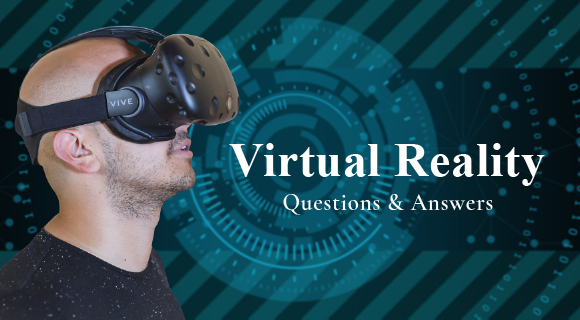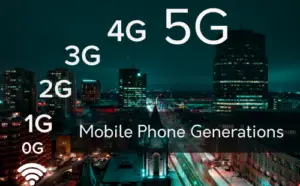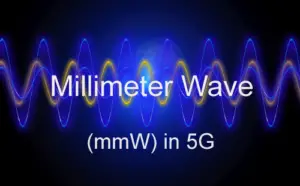Virtual Reality Interview
Virtual Reality (Short Name VR) is the use of computer technology to create a simulated environment. Virtual Reality (VR) diverges from conventional user interfaces by enveloping users within an immersive experience. Rather than merely observing a screen, users find themselves inside 3D environments, facilitating interactive engagement.
Through the emulation of multiple senses, including sight, sound, touch, and even smell, the computer assumes the role of a portal to this synthetic realm.
Virtual reality (VR) is a realistic three-dimensional image (3D image) or artificial environment that is created with a mixture of interactive hardware and software, and presented to the user in such a way that the any doubts are suspended and it is accepted as a real environment in which it is interacted with in a seemingly real or physical way.
Enhanced Reality Desktop virtual Reality Telepresence QTVR (QuickTime Virtual Reality) Mixed reality Augmented Reality Another classification scheme has been delineated by Brill (1993; 1994b). This model will be discussed in detail here. Brill’s model features seven different types of virtual reality:
Total immersion means that the sensory experience feels so real, that we forget it is a virtual-artificial environment and begin to interact with it as we would naturally in the real world. In a virtual reality environment, a completely synthetic world may or may not mimic the properties of a real-world environment. This means that the virtual reality environment may simulate an everyday setting (e.g. walking around the streets of London), or may exceed the bounds of physical reality by creating a world in which the physical laws governing gravity, time and material properties no longer hold (e.g. shooting space aliens on a foreign gravity-less planet).
Augmented Reality (AR): Augmented reality (AR) adds digital elements to a live view often by using the camera on a Smartphone. Examples of augmented reality experiences include Snapchat lenses and the game Pokémon Go. Virtual Reality (VR): Virtual reality (VR) implies a complete immersion experience that shuts out the physical world. Using VR devices such as HTC Vive, Oculus Rift or Google Cardboard, users can be transported into a number of real-world and imagined environments such as the middle of a squawking penguin colony or even the back of a dragon. Mixed Reality (MR): In a mixed reality (MR) experience, which combines elements of both AR and VR, real-world and digital objects interact. Mixed reality technology is just now starting to take off with Microsoft’s HoloLens one of the most notable early mixed reality apparatuses.
History of virtual reality Here are a few of the more interesting highlights In 1890s: Thomas Edison and his assistant William Dickson pioneer the Kinetograph (a camera for recording pictures) and Kinetoscope (a projector for playing them back)—in effect, the first one-person “movie experience.” In 1895: French brothers Auguste and Louis Lumière open the first movie theater in Paris, France. Legend has it that one of their movie shorts, Arrival of a Train at La Ciotat, is such a convincing depiction of reality that people in the audience scream and run to the back of the room. In 1929: Edwin Link develops the Link Trainer (also called the Pilot Maker), a mechanical airplane simulator. His work pioneers the field of flight simulation. In 1950: US Air Force psychologist James J. Gibson publishes an influential book, The Perception of the Visual World, describing how people see and experience things as an “optic flow” as they move through the world. These ideas, and those of contemporaries such as Adelbert Ames, help to form the foundations of the 20th century psychology of visual perception, which feeds into academic studies of computer vision and virtual reality. In 1956: Cinematographer Morton Heilig begins developing machines that can produce artificial sensory experiences. In 1957, he develops a pioneering 3D head-mounted display. In 1962, he’s granted a patent for a machine called the Sensorama (a kind of updated, highly sophisticated Kinetoscope) that can immerse its user in artificial vision, sound, smell, and vibration. Many people regard Heilig as the true father of virtual reality, though he has seldom been acknowledged as such. In 1961: C. Comeau and J. Bryan make Head sight, the first real head-mounted display. In 1962: Ivan Sutherland, pioneer of human-computer interaction, develops the lightpen and a program called Sketchpad that allows people to draw on a computer screen—opening the way for the kind of computer graphics later used in virtual reality. In 1965: Sutherland develops Ultimate Display, a sophisticated HMD. In 1968. Sutherland produces a HMD with stereo (3D) vision. In 1970s: Computer scientist Myron Krueger opens Video place, a pioneering VR laboratory. In 1975-1976: Programmer Will Crowther develops Adventure (also called Colossal Cave Adventure), a highly influential, text-based computer game in which players explore a virtual world, solving problems through a question and answer dialog. In 1977: Dan Sandin, Richard Sayre, and Thomas Defanti produce the first data glove. In 1980s: Fast 3D graphical workstations, notably those developed by Silicon Graphics, accelerate the development of scientific visualization, visual computer modelling, CGI movies, and VR. In 1982: Tron, a pioneering CGI movie, tells the story of a software engineer (played by actor Jeff Bridges) who ventures into the software of a mainframe computer. In 1983: Computer scientist Myron Krueger coins the term “artificial reality.” In 1983: Writer William Gibson invents the related term “cyberspace.” In 1989: Computer scientist and musician Jaron Lanier: coins the now preferred term “virtual reality.” His company, VPL Research, garners huge media attention and develops pioneering VR peripherals, including a HMD and data glove. Lanier has been popularly referred to as the “father of virtual reality” ever since, though, as this timeline demonstrates, he was quite a late entrant to the field! In 1992: The Lawnmower Man, another influential VR film, based on a Stephen King story, is partly inspired by the story of VPL. In 1993: Brothers Robyn and Rand Miller create Myst, an extremely successful graphical computer game, in which players explore an island in non-immersive virtual reality. In 1994: Dave Raggett, an influential English computer scientist who has played a key role in the development of the World Wide Web, coins the term VRML (Virtual Reality Markup Language). In 1999: The Matrix, a movie starring Keanu Reaves based on virtual reality, grosses over $450 million at the box office. In 2011: Palmer Luckey develops the Oculus Rift, an inexpensive homemade HMD, in his parents’ garage. In 2014: Facebook announces its acquisition of Oculus in a deal worth $2 billion. In 2016: Oculus begins shipping its Rift headsets to customers to generally positive reviews. Meanwhile, a variety of Smartphone makers (including Samsung and HTC) produce rival VR systems, VR also appears for PlayStation, and Google announces it has shipped over 5 million cardboard head-mounted displays for smart phones. In 2017: Sony reveals that it sold almost a million PlayStation VR headsets in their first four months on the market. In 2018: In 2019: In 2020: In 2021-2022: In 2023-2024: Current Trends: Source: Explain that Stuff and Reality technologies
There’s no one correct answer here, but it’s important to get a sense of how a VR developer thinks of their medium. All three mediums require strong storytelling to be effective, but VR also comes with its own challenges: Some examples could include working without a frame, needing to find ways to teach new users how to navigate the experience, or the need to develop new tools and technologies.
Read : What is Machine Learning and History of ML?
Two major trends are Moore’s law and materials science. On the Moore’s law side, pretty good levels of 3D rendering have become commoditized and are already miles ahead of what we could do not so many years ago for millions of dollars. Cheap, fast computing power is thus the muscle that’s driving this today. Materials science, on the other hand, is bringing us better chips, improved optics, sensors, actuators and displays. These things are driving our experiences in the virtual world and opening up great new possibilities.
One of the challenges of developing for VR is that it needs to be able to work even when the user doesn’t necessarily know what they’re doing. That means you’ll need to do extensive testing to gauge how users are interacting with your experience and make changes if necessary.
Virtual Reality Modelling Language(VRML) is an ISO/IEC language developed by a combined effort of a group of companies and 3D designers and programmers for describing 3D scenes on the Web (fortunately from the beginning the effort converged to make it standard, no such luck with HTML until W3C was created). The documents have *.WRL extensions that can be viewed by a browser with an appropriate plugin or helper-application
VRML is a scene description language that standardizes how three-dimensional environments are represented on the Web. Unlike programming languages such as “C++”, VRML does not have to be compiled and run. Rather, VRML files get parsed and then displayed. Since this is a much faster process, the creation of VRML files is much simpler than programming. It also allows for more interactivity and facilitates incremental improvements. Here is how VRML works from the user’s perspective.
Nodes are the basic blocks for creating your scene. Each kind of node has specific field, values and children statements that are always inserted between { }, so never forget to close your nodes.
Certain nodes have a stack associated with them onto which they may be pushed and popped The node at the top of this stack is applied to the scene (there is always a default) The set_bind event sent to a bindable node, pushes or pops it The list of bindable nodes is: Don’t worry – you can’t do any damage by popping too many times
Sensors can be thought of in two categories, those associated with geometry and one for sensing time. The list of sensors is: The sensors can respond to various conditions such as proximity to an avatar,mouse clicks, mouse movement or whether an object is in the field of view of the user. In addition, cylinder, sphere and plane sensors move the geometry associated with them when they are active Do not place a sensor in the same transform node as the geometry as this can result in undefined behaviour.
VR headset refers to a device worn over the eyes like a pair of goggles for the purposes of watching VR content or when playing virtual reality video games. Most of the headsets have the ability to track the user’s head movements so that the wherever the user looks, the character in the virtual reality also looks. If done in the right manner, the headsets give an impression of the user being actually inside the game or the movie, hence the name “virtual reality”.
Some of the best Headsets are
What is a Virtual Reality (VR)?
What are the different types of virtual reality?
What is Total Immersion in VR?
What is the difference between AR, VR, and MR?
Complete history of Virtual Reality (VR) (1890s to 2024)?
Focus on standalone headsets: Standalone VR headsets like the Oculus Go gained popularity, offering an accessible entry point without needing a PC.
Gaming dominance: VR gaming remained a significant driver, with popular titles like Beat Saber and Superhot VR.
Rise of enterprise VR: VR applications in training, simulation, and design saw increased adoption across various industries.
Focus on improved visuals: High-resolution headsets like the Valve Index entered the market, pushing the boundaries of graphical fidelity.
Impact of the pandemic: VR adoption saw a surge due to increased demand for remote communication and entertainment options.
Rise of fitness VR: Apps like FitXR and Beat Saber gained traction, promoting VR as a viable fitness tool.
Stagnant growth: The VR market witnessed slower growth, with users waiting for significant advancements before upgrading.
Metaverse hype: The concept of the metaverse gained significant attention, with companies like Meta (formerly Facebook) positioning VR as a key component.
Shift towards mixed reality: The emergence of mixed reality headsets blurring the lines between physical and virtual spaces, like Meta Quest 3 and Apple’s Vision Pro.
Focus on user experience: Advancements in avatars, haptics, and hand tracking aimed at enhancing the sense of presence and immersion in VR experiences.
5G integration: The rollout of 5G networks promises smoother, faster VR experiences with reduced latency and improved streaming capabilities.
Decline of dedicated VR headsets: Mixed reality headsets are expected to become the dominant form factor, offering both VR and AR capabilities.
Hyper-realistic avatars: Increased focus on creating realistic and expressive avatars for enhanced social interaction and emotional connection in VR spaces.
VR applications beyond gaming: Continued exploration of VR’s potential in various sectors like education, healthcare, remote collaboration, and even tourism.
What sets VR development apart from traditional animation or game design?
What are the major trends driving the introduction of Virtual Reality systems?
How do you test a VR experience?
What is VRML?
What does VRML do?
What are Nodes in VRML?
What is bindable node?
Explain Prototypes in VRML?
Explain Sensors in VRML language?
What is Virtual Reality Headset (VR Headset)?
What are the best headsets of VR?




